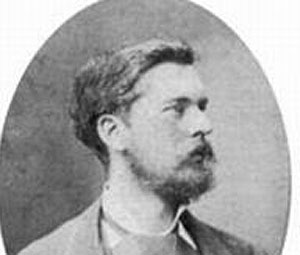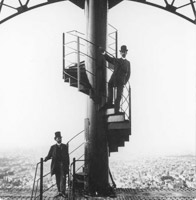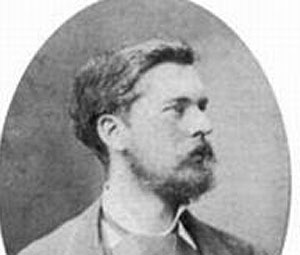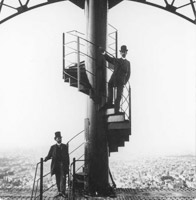CUBAN MEDIA EXALT FALSE STORIES.
First was that cook at Buckingham Palace after the Cuban origins of the Miss Universe 2011, Leila Lopes, and now … Cuban engineer who helped build the Eiffel Tower.
The online edition of Somos Jovenes and on the website of Radio Rebelde recently published history-literally incredible-Cuban engineer Guillermo Perez Dressler.
 PAINTER JOHN ENGLISH SINGER-SARGENT, IDENTIFIED AS THE FALSE CHARACTER
PAINTER JOHN ENGLISH SINGER-SARGENT, IDENTIFIED AS THE FALSE CHARACTER
According to both media, which does not cite any sources, Dressler was “the real builder of the Eiffel Tower” and “Cubans who left their mark on the Eiffel Tower”, a story that is straight out of a fairy tale .. . Cuban.
Not to be outdone, the enigmatic character was included in the official digital encyclopedia EcuRed, which emerges as a sort of Criollo Wikipedia to serve the educational system of the island.
Other media such as Radio Angulo y Alternative Visions, de Prensa Latina, reproduced the apocryphal story.
According to the references of Cuban publications, Perez was born in Guanabacoa Dressler in 1860. At age 15 his father died and his family was ruined, but a teacher friend, aware of his talent as a draftsman, he “handles” a scholarship to the Sorbonne in Paris. There happens to be Guillaume Dressler, graduating with honors, the tomb built by Ludwig II in Munich and later he met Gustave Eiffel and became his “right hand” in building the famous tower in Paris … since the French businessman and engineer “suffered vertigo” and could not go beyond the first floor.
But the biography, roots and identity of the alleged Cuban engineer can not be more imaginative: one of the rag balls that often these days happily serve the internet pranksters.
Dressler Perez never existed. The apocryphal story began circulating for over a year on various blogs, attributed to the “renowned journalist and author Demis-Smaerd Yenobis, born in Cuba in 1968.” The supposed author was married to a Swede named Björn Smaerd. As some readers pointed then in the blogosphere, the name of the “journalist” is just an anagram and backward means “Siboney of my dreams”.
Artist English by Cuban engineer
The photo used to identify Dressler is a picture of 1880 by the English painter John Singer-Sargent (1856-1925). Another image that circulated on the Internet with Photofunia story was taken from a site special effect applied to photos.
But history has the last word. As reflected in the official website of the Paris iconic building, architectural design was proposed by entrepreneur Gustave Eiffel, the chief engineers Maurice Koechlin and Emile Nouguier, and architect Stephen Sauvestre, and was chosen for the tower to be erected on the occasion Universal Exhibition of 1889.

GUSTAVE EIFFEL AT THE TOP OF THE TOWER THAT BEARS HIS NAME. PHOTO TAKEN THE OFFICIAL SITE OF THE EIFFEL TOWER
Eiffel design included as part of the engraving of the names of 72 engineers and scientists who contributed decisively to the construction, and are currently on the sides of the building below the first balcony.
The list can be found online and it is clear that no Hispanics participated in the work-and if there is any doubt, no name even remotely resembles “Guillermo Perez Dressler” or “Guillaume Dressler.”
The apocryphal story is full of references and details that reveal the joking tone that has been written. The Eiffel vertigo course is just one of them. In fact, the French engineer had no problem with height, but just the opposite: it established an office at the top of the tower, where he received his guests.
Ironically, the only interesting fact related to the Caribbean island that is part of the history of the Eiffel Tower was ignored by the Cuban media: shortly before the arrival to power of Fidel Castro in 1959, the Cuban intellectual Walterio Carbonell (1920-2008 ) hoisted a flag of the July 26 Movement from the first balcony of the legendary Parisian building.
Walterio Carbonell, an important Afro-Cubano intellectual at the the triumph of the Cuban revolution was appointed ambassador to Tunisia, but was replaced because of alleged irregularities in conduct, among which counted a car accident involving fatalities. In Cuba were attributed to attempts to create a Marxist section of the Black Power and was sent to meet labor in cane cuts in the mid 60s. Scruffy and suffering from nervous disorders in recent years as a researcher at the National Library.
He died in Havana at 88 years of age.
CafeFuerte/IvetteLeyvaMartinez/
InternetPhotos/TheCubanHistory.com
Medios Oficiales Cubanos Exaltan Historias Falsas
The Cuban History, Hollywood.
Arnoldo Varona, Editor.
MEDIOS OFICIALES CUBANOS EXALTAN HISTORIAS FALSAS.
Primero fue aquel cocinero en el Palacio de Buckingham, luego los orígenes cubanos de la Miss Universo 2011, Leila Lopes, y ahora… el ingeniero cubano que ayudó a construir la Torre Eiffel.
La edición digital de Somos Jóvenes y en el website de Radio Rebelde publicaron recientemente la historia -literalmente increíble- del ingeniero cubano Guillermo Pérez Dressler.
 PINTOR JOHN ENGLISH SINGER-SARGENT, MAL IDENTIFICADO.
PINTOR JOHN ENGLISH SINGER-SARGENT, MAL IDENTIFICADO.
Según ambos medios, que no citan a ninguna fuente, Dressler fue “el verdadero constructor de la torre Eiffel”, y “el cubano que dejó su impronta en la torre Eiffel”, en una historia que parece salida de un cuento de hadas… cubano.
Para no quedarse atrás, el enigmático personaje fue recogido en la enciclopedia digital oficialista Ecured, que emerge como una suerte de Wikipedia criolla al servicio del sistema educacional de la isla.
Otros medios, como Radio Angulo y Visiones Alternativas, de Prensa Latina, reprodujeron la historia apócrifa.
De acuerdo con las referencias de las publicaciones cubanas, Pérez Dressler nació en Guanabacoa en 1860. A los 15 años murió su padre y su familia quedó arruinada, pero un profesor amigo, conocedor de su talento como dibujante, le “tramita” una beca para la Sorbona en París. Allí pasa a ser Guillaume Dressler, se gradúa con honores, construye la tumba de Ludwig II en Munich y más tarde conoce a Gustave Eiffel y se convierte en “su mano derecha” en la construcción de la famosa torre parisina… ya que el empresario e ingeniero francés “padecía vértigo” y no podía subir más allá del primer piso.
Pero la biografía, raíces cubanas e identidad del presunto ingeniero no pueden ser más fantasiosas: una de las pelotas de trapo que suelen servir alegremente por estos días los bromistas de la internet.
Pérez Dressler no existió nunca. La historia apócrifa comenzó a circular hace más de un año en varios blogs, atribuida a la “reconocida periodista y escritora Yenobis Demis-Smaerd, nacida en Cuba en 1968”. La supuesta autora estaría casada con un sueco llamado Björn Smaerd. Como apuntaron algunos lectores entonces en la blogosfera, el nombre de la “periodista” no es más que un anagrama y al revés quiere decir “Siboney de mis dreams”.
Pintor inglés por ingeniero cubano
La foto usada para identificar a Dressler es una imagen de 1880 del pintor inglés John Singer-Sargent (1856-1925). Otra imagen que han circulado en internet con el relato fue sacada de Photofunia, un sitio de efecto especiales aplicados a fotos.
Pero es la Historia quien tiene la última palabra. Tal como recoge el sitio oficial del icónico edificio de París, el diseño arquitectónico fue propuesto por el empresario Gustave Eiffel, los jefes ingenieros Maurice Koechlin y Emile Nouguier, y el arquitecto Stephen Sauvestre, y fue el elegido para la torre que se erigiría en ocasión de la Exposición Universal de 1889.

GUSTAVE EIFFEL EN LA CIMA DE LA TORRE QUE LLEVA SU NOMBRE. FOTO TOMADA DEL SITIO OFICIAL DE LA TORRE EIFFEL
Eiffel incluyó como parte del diseño el grabado de los nombres de 72 ingenieros y científicos que contribuyeron de forma decisiva a la construcción, y actualmente se encuentran en los lados del edificio, debajo del primer balcón.
La lista puede ser consultada online y queda claro que ningún hispano participó en la obra -y por si queda alguna duda, ningún nombre se parece ni remotamente a “Guillermo Pérez Dressler” o “Guillaume Dressler”.
La historia apócrifa está llena de guiños y detalles que delatan el tono bromista con que ha sido escrita. El supuesto vértigo de Eiffel es sólo uno de ellos. En realidad, el ingeniero francés no tuvo ningún problema con la altura, sino todo lo contrario: estableció una oficina en la cima de la torre, donde recibía a sus invitados.
Irónicamente, el único dato curioso relacionado con la isla caribeña que forma parte de la historia de la torre Eiffel fue obviado por los medios cubanos: poco antes de la llegada al poder de Fidel Castro en 1959, el intelectual cubano Walterio Carbonell (1920-2008) izó una bandera del Movimiento 26 de Julio desde el primer balcón de la mítica edificación parisina.
Walterio Carbonell, un destacado intelectual afro-cubano al triunfo de la revolución fue nombrado embajador en Tunez, pero fue sustituido del puesto por supuestas irregularidades en su conducta, entre las que contaron un accidente automovilístico con víctimas fatales. En Cuba se le atribuyeron intentos de crear una sección marxista del Black Power y fue enviado a cumplir trabajos forzados en los cortes de caña, a mediados de los años 60.
Desaliñado y aquejado de transtornos nerviosos, en los últimos años se desempeñó como investigador en la Biblioteca Nacional.
Murio en la Habana a los 88 años de edad.
CafeFuerte/IvetteLeyvaMartinez/
InternetPhotos/TheCubanHistory.com
Medios Oficiales Cubanos Exaltan Historias Falsas
The Cuban History, Hollywood.
Arnoldo Varona, Editor



 CUBAN MEDIA Exalt False Stories (Photos) * * MEDIOS OFICIALES Cubanos Exaltan Historias Falsas (Fotos).
CUBAN MEDIA Exalt False Stories (Photos) * * MEDIOS OFICIALES Cubanos Exaltan Historias Falsas (Fotos).